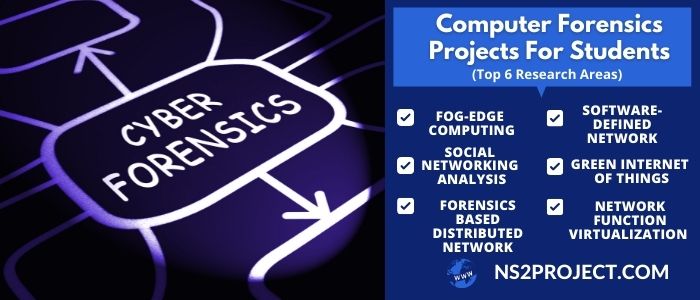Computer forensics is a collection of techniques used to develop investigation applications for identifying the original proofs which are intentionally hidden during criminal activities. The motive of these techniques is to collect the evidence and preserve them in computing devices against malicious activities until the court presentation. In fact, computer forensics is also referred to as cyber forensics and digital forensics.
We prepare this page with an aim to provide significant research information about the computer forensics field for the benefit of final year students
Our resource team is usually best in designing, developing, and deploying the models of computer forensics. Since, we are skillful in modeling upgraded protocols, policies, standards, and algorithms in managing security and privacy in computer forensics. Also, we provide the best solution for other security and data breaches using smart techniques. For your information, here we have given the synopsis of this page,
- Fundamentals of computer forensic analysis
- Essentials to tracking hacker’s intension
- Cryptography importance in computer forensics and cybersecurity
- Taxonomy interpretation on computer forensics and cybercrimes
- And many more

What is Computer Forensics?
- Computer forensics is defined as the sequential operations conducted to reveal the evidence which hidden in crime actions
- It is very valuable in crime related cases to present digital evidences for court acceptance
- In some aspects, it is addressed as electronic discovery, digital discovery, data discovery, electronic evidence discovery, computer examination / analysis and etc.
- Further, it performs acquisition, conservation, analysis, documentation and presentation on computer-oriented media for evidences
The fundamental sequential techniques used for investigating the event in computer forensics are given as follows,
- Collect evidences from source without disturbing the source place
- Match the recorded evidence with source evidence for authentication
- Examine the evidence without modifying the original meaning of the evidence
In order to acquire accurate results, the methodologies/techniques used for investigation is need to be updated to match with advancing technologies. Since the fundamental techniques are outdated and not adaptable to deal with modern technologies. Once you make a contact with us. We let you know both modern algorithms and technologies in computer forensics. All our computer forensics projects for students are based only on modern technologies.
Taxonomy of Computer Forensics
- System Events
- Read
- Authenticate
- Copy
- Scan
- Manipulate
- Spoof
- Delete
- Flood
- Steal
- Bypass
- Probe
- Susceptibility
- Network Configuration
- Social Engineering
- Network Model Design
- Human Behavior
- Model Development
- Attacker’s Aim / Target
- Network
- Information
- Network Entity
- Process
- Internetwork
- System / Computer
- User Account
- Source
- Defective Software / Hardware
- Insufficient Resources
- Disrupted Security Aspect
- Non-repudiation
- Authenticity
- Availability
- Confidentiality
- Integrity
- Timeline
- Recurring (completed and ongoing incident)
- Single (completed and ongoing incident)
- Tool
- User Command
- Toolkit
- Distributed Tool
- Data Interchange
- Autonomous Agent
- Physical Damage
- Data Tap
- Program / Script
- Outcome
- High accessibility
- Denial of Service
- Data Revelation
- Degraded Data
- Resource / Data Theft
The main objective of computer forensics projects for students is to identify and preserve the original evidence by following structured investigation procedures (collection, detection, and validation). To the end, reconstruct the event for new evidence. For better understanding, here we have given you some benefits of computer forensics.
Uses of Computer Forensics
- Robust to recover the defected systems
- Perform pre-trial in court of law
- Enable to search free space on large-scale hard drive / other storage
- Easy to recover deleted data
- Reconstruct the security related events in computer
- Simple to analyze the internal crimes and violation
- Capable to find the hidden files by reconstruction process (use date codes and timestamp)
- Allow to perform string based search for e-mail (in absence of client email)
- Simplify the process of trouble shooting
- Ability to collect digital artifacts which unknowingly left by OS (our experts are good in detecting and evaluating artifacts)
Specifically, the computer forensics field will provide you the best opportunity to create different kinds of real-time models for enhancing security in modern systems. On knowing the importance of security in the computer forensic field, here we have listed various security-based computer forensics models.
Types of Computer Forensics Systems
- Satellite Encryption Security
- Network Disaster Recovery
- Identity Theft Prevention
- Firewall Security
- Network Security (Wireless)
- Instant Messaging (IM) Security
- Internet Security
- Storage Area Network Security
- Identity Management Security
- Public Key Infrastructure (PKI) Security
- Intrusion Prevention / Detection (IP / ID)
In addition, we have also included the procedure to create the security-based computer forensic models. By following all these steps, you can surely create the best computer forensics projects for students based on below model. Since it encloses effective security measures against the attacks
Workflow for Computer Forensics Model
- Step 1 – At first, collect the activities of user, network, application and database as input securely from multiple sources
- Step 2 – Then, perform different operations like preprocessing, collation and transformation on structured and unstructured data
- Step 3 – Next, design the learning techniques based security model for following purposes,
- Detection of abnormal patterns
- Engineering security characteristics
- Forecast and Classification of Attacks
- Policy rule generation
- Custom-based model selection
- Association learning
- Clustering similar incidents / data
- Step 4 – Implement the learning and dynamism for the followings,
- Incident response plan and decision making
- Security model update
- Post-processing and enhancement
- Recency mining
Next, we can see the recent security-related threats and attacks in computer forensics. Beyond these issues, we have the stock of several issues from a different aspect of computer forensics. We are good not only at identifying issues but also at solving issues through modern technologies.
Research Issues in Computer Forensics
- Phishing
- Aiming to get user private information for own purpose
- Types – spear phishing, clone phishing, etc.
- Unlawful Access
- Accessing legal users data their permission (i.e., illegally)
- Disturbing or Annoying Someone Online
- Person irritate someone for personal reasons / poking fun
- Scam
- Misleading persons to rely on fake things like advertisements
- Identity Theft
- Pretend to act as real users by stealing their identity
- Denial of Service
- By sending voluminous requests, make the network busy to prevent the resources access of legal users
All the above-specified issues are major threats to the growth of the computer forensic field. Since it has the capability to create a high impact on the modern digital world. Though several intelligent techniques are utilized, one of the major concerns in computer forensic is security. In addition, cyber forensic also gain the same level of concern in utilizing modern technologies. In the following, we have listed few growing technologies which assure the best computer forensics projects for students.
Research Topics in Computer Forensics
- Fog-Edge Computing
- Social Networking Analysis
- Cloud-Edge / Cloud-Fog Computing
- Forensics based Distributed Network
- Software Defined Network Projects (SDN)
- Green Internet Of Things (Green IoT)
- Network Function Virtualization (NFV)
Our developing team is currently working on an unlimited number of Computer Forensics Projects for students and research scholars. So, we are updated in all current research ideas from top research areas of computer forensics. For your awareness, here we have listed only a few of them. Further, we are ready to more on other areas and also give ideas on your interested areas.
Current Research Ideas in Computer Forensics
- Blockchain based Security Schemes in Cloud Services
- Modeling of Trust-based Services in Cloud Computing
- Forensic based Remote Health-care Monitoring System
- Network Virtualization and Security
- Learning based Extraction and Querying of Evidence
- Security in Fog, Federated Cloud and Edge Computing
- Big Data Visualization and Forensics
- Security Threats and Risk Analysis in Cloud Computing
- Information Security in IoT
- Cloud Data Auditing and Accounting using Forensic Methods
- Improved Digital Artifacts with Dual Implications
- Malware Detection, Attribution and Analysis
- Employment of Multi-Factor Authentication for Evidence Access
- Evidence Quality and Validity Enhancement using Cryptographic Techniques
Generally, we perform a combination of analysis and investigation strategies to collect evidence that is acceptable in court. These integrated techniques are used to execute detection, protection, extraction, interpretation, and documentation processes. If the chain of evidence is managed correctly, then it is better to perform a sequential/structured chain of evidence. As a result, we can identify how the incident occurred, what is the source of the incident, who created the incident, what impact that the incident created, etc. All these questions are answered properly only if you select appropriate techniques. Below, we have listed few effective techniques that give the expected output in computer forensics.
Techniques for computer forensics
- Data hiding Techniques
- Disk Manipulation
- Encryption
- File Manipulation
- Wrapper Techniques
- Leave-one-out Calculation Sequential Forward Selection (LOOCSFS)
- Genetic Algorithm-Support Vector Machine (GA-SVM)
- Best Incremental Ranked Subset (BIRS)
- Steganography Techniques
- File creation
- Injection Methods
- Stego Encryption
- Substitution Methods
- Filter Techniques
- ReliefF
- Mutual Information
- Minimum Redundancy Maximum Relevance
- Markov Blanker Filtering
- Correlation-based Feature Selection
- Embedded Techniques
- Information Gain Ranking
- Unconditional Mixture Modeling
As a matter of fact, digital forensics tools are differentiated based on several parameters/attributes such as registry analysis, network forensics, internet analysis, database forensics, mobile device analysis, email analysis, file viewers/analysis, data and disk capture. Here, we have listed some widely preferred tools for computer forensics projects.
What are the Simulation tools for computer forensics?
Tools for Computer Forensics Projects
- Helix3 Forensics
- Support ubuntu assisted live CD
- Wireshark
- Network capture / packet analyzer tool
- Monitor and inspect the network related events
- Examine network packet information
- AccessData
- Comprises FTK (Forensic Toolkit) Imager
- Pyflag
- Addresses as Forensic and Log Analysis GUI (FLAG)
- Enable to investigate huge-scale log files
- Ability to enhance, utilize and manipulate logs
- NMAP
- Expanded as Network Mapper
- Map the network activities
- Auditing of network security
- Microsoft tools
- Include utilities such as Sysinternals (Terminal and GUI) and TCPView
- WinAudit
- Allow to audit computer based data / inventory
- NirSoft tools
- Consists of USBDeview, Opened FilesView, RegScanner, ShellExView, PNetInfo, Windows tools, ActiveXHelpe, Mail Pass View, IECookiesView, IEHistoryView, Messenger Pass, IEPassView, ProduKey, etc.
Basically, there are so many tools in computer forensics. Though there are several tools, it differs from characteristics. So, we can see the tool based on the investigation process that we going to pursue in the development phase of computer forensics projects for students. Here, we have given some interesting characteristics that vary from tool to tool.
How to choose the simulations for computer forensic projects?
- Data Localization
- Data Acquisition
- Data Filtering / Extraction
- Data analysis by Penetration Test
- Data Creation, Storage and Manipulation Time and Data Stamps
- Data integrity by Disk Hashing
- Data Storage and Backup
On the whole, we ensure that our research experts will provide you best research guidance in handpicking research topics, research problems, and solutions. Similarly, our developing experts will provide you best assistance in handpicking development tools, datasets along with code execution. So, if you are interested to gain all these benefits then approach us. We are here to deliver remarkable computer forensics projects for students.








